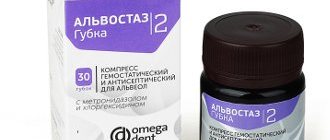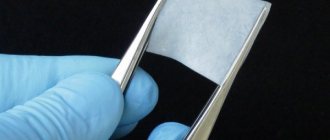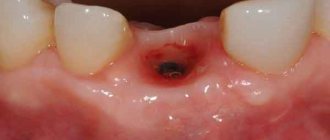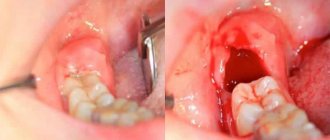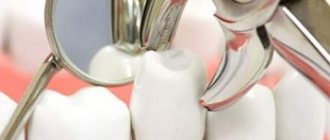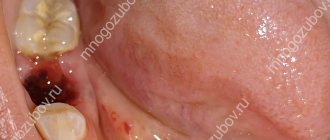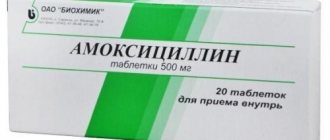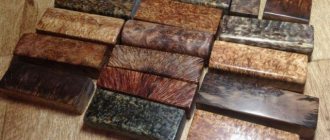Indications for use
In medical practice, a hemostatic sponge is used in the following cases:
- In case of severe damage to the skin;
- For bleeding;
- With bleeding from the sinus of the dura mater;
- For trophic ulcers;
- For bedsores;
- With otitis media;
- When bleeding from the nose;
- In dentistry.
Tampons Hemostatic sponge – review
Good afternoon
Today I want to talk about one very important medical product that has been constantly present in my medicine cabinet for 13 years - a hemostatic collagen sponge.
This miracle of medical thought is usually used in hospitals to apply to wounds to stop bleeding, including during operations. However, I try to always keep a package with a sponge in my home medicine cabinet, for a reason that I will outline below.
During surgical interventions in hospital conditions during operations such as traditional and laparoscopic cholecystectomy, hernia repair, acute appendicitis, after treatment of lacerated and bruised wounds, treatment of wounds healing by secondary intention in pancreatitis, filling defects of parenchymal organs and stopping parenchymal bleeding, covering anastomoses, during operations in gynecology, otorhinolaryngology, and many other cases. The stages of inflammation occur in a shorter period of time. The therapeutic effect of the sponge lasts for 2-3 days without replacing it. The use of the sponge does not cause any complaints from patients.
Manufacturer: Luga plant Beokozin, St. Petersburg.
Tampons Hemostatic sponge
Clinical trials were carried out on the basis of St. Petersburg State Medical University named after. I.P. Pavlova, Military Medical Academy named after. CM. Kirov, Department of Emergency Surgery, St. Petersburg MAPO.
Shelf life: 3 years.
Tampons Hemostatic sponge
Release form:
Hemostatic sponge is produced with a thickness of 7±2 mm, dimensions (50±5) × (50±5) mm and (90±10) × (90±10) mm, in individual packaging.
Compound:
collagen solution 2%
furatsilin
boric acid
Sponges are sold in small cardboard boxes, inside which are instructions and the product itself, sealed in an airtight film.
Tampons Hemostatic sponge reviews
Tampons Hemostatic sponge reviews
Tampons Hemostatic sponge reviews
Sterile.
It has a yellowish color , an air-porous structure, somewhat reminiscent of foam rubber. I don’t smell the smell as such, but maybe the slight aroma of the hospital (due to furacillin and boric acid) can be detected.
How to stop nosebleeds?
The hemostatic sponge has a hemostatic and antiseptic effect, stimulates tissue regeneration. The thickness of the plate makes it easy to model the contours to be covered when applied to damaged areas of tissue. Adhesives (sticks) well to the wound surface.
This product has one important feature -
it completely dissolves upon contact with a bleeding area, that is, you should not remove the sponge from the wound.
Contraindications:
The use of a hemostatic sponge is contraindicated in case of arterial bleeding, individual intolerance to the nitrofuran series (furacilin, furagin). Purulent wounds, pyoderma.
Instructions.
Tampons Hemostatic sponge reviews
Tampons Hemostatic sponge
EXPERIENCE OF USE.
My acquaintance with the hemostatic sponge took place in the spring of 2006. I admit, this was not the best spring in my life: I was finishing 11th grade, stress, exams, spring vitamin deficiency...
All this led to the fact that around March I started having constant nosebleeds, which could happen 1-2 times a day: at school, on the street, at home. The worst thing was that blood could come from the nose even in a dream, it would immediately flow into the throat...
Waking up to the fact that you are choking on it is not the most pleasant feeling.
At first I stopped the bleeding with hydrogen peroxide. In most cases, if the vessels in the nose are not severely damaged, following the correct technique, the bleeding can be stopped in 5-10 minutes.
Below is my proven scheme, because 2 months of constant practice were not in vain for me:
- MUST take a static position, sit down, and calm down. You can't lie down.
- Under no circumstances should we throw our heads back! This is the biggest mistake people make. If you do this, the blood will start flowing down your throat and you will simply begin to choke.
- Ideal position: sit up straight, tilt your head SLIGHTLY forward.
- Take hydrogen peroxide and sterile cotton wool.
- We make a cotton swab, soak it in hydrogen peroxide, and carefully insert it into the damaged nostril.
- We sit quietly with our heads slightly tilted forward for about 10 minutes, tucking the wings of our nose with our fingers.
- If necessary, change the tampon with peroxide.
- If possible, you can put ice on the bridge of your nose.
If the bleeding is not severe, then this will be enough to stop it. And at first I succeeded, but after a while the vessels were severely damaged, did not heal, and it took me at least an hour to stop the bleeding.
Probably about a week after my torment began, I was sitting in class and my nose began to bleed very badly. I headed to the first aid station. The nurse (by the way, we had a very nice girl), assessing the scale of the problem, after peroxide did not help me, inserted a hemostatic sponge, a small piece, into my nose.
This is how our meeting took place:
- The sponge quickly absorbed all the blood, it no longer flowed from the nose.
- After a while there was a feeling that, excuse me, there was a big booger stuck in my nose that I really wanted to blow my nose. This should not be done, as bleeding may resume.
- After about a day, the sponge dissolved on its own.
How did my story end?
I wanted to buy such a useful thing for home, but in 2006 the sponge was not sold in pharmacies.
Since I was still bleeding, the nurse gave me a piece of sponge to take home. I went to the hospital with my problem, I don’t remember exactly what the doctor told me, but they prescribed me some vitamins. Periodically, I still had bleeding somewhere until the middle or end of May; I did not use the sponge every time to stop it, but I will say that it helped me out a lot then.
I have never had such a large series of nosebleeds again (pah-pah-pah), but the fear that they might happen again still lives in me.
Therefore, as soon as sponges began to appear on sale, I started buying them for my home medicine cabinet.
I’ll say right away that
I don’t apply them to cuts and abrasions on the body (there was simply no such need), but I still use them for nosebleeds (of moderate and increased intensity).
Probably, over the past 13 years since 2006, I have resorted to the services of a sponge no more than 6-7 times, but I continue to buy it and periodically update it in my medicine cabinet, because it makes me feel safer.
How to use a sponge to stop nosebleeds?
- After all the measures to eliminate bleeding indicated above have been taken (sit down, tilt your head slightly, insert a cotton swab with peroxide into the nostril), you need to cut off a small piece of the sponge and, preferably with a clamp (if you have one), or insert the sponge with clean hands into a bleeding nostril.
- Next, you should sit for a while with your head tilted forward to make sure that the bleeding has stopped.
- You shouldn’t take the sponge out of your nose; it will dissolve on its own within a day.
Let's summarize.
Tampons Hemostatic sponge. Stop nosebleeds.
I believe that a hemostatic sponge should be in every home medicine cabinet. It is not always possible to stop bleeding with peroxide, chlorhexidine, bandages and cotton wool.
Advantages:
- efficiency
- price
- self-resorption
- stop bleeding
Among the shortcomings, I can only note that the sponge cannot be found in every pharmacy, but now, in the age of the Internet, I think it’s not a problem to find out where it is.
THANK YOU ALL FOR YOUR ATTENTION!
Source: https://irecommend.ru/content/kak-ostanovit-silnoe-krovotechenie-iz-nosa-v-domashnikh-usloviyakh-kogda-perekis-uzhe-bessil
Mode of application
The hemostatic sponge is intended for local use and is used as a tampon. In the case when a sponge is applied to a wound from which blood is coming, after about 5 minutes it becomes saturated and envelops the wound in a dense layer. If the blood does not stop on the wound, another sponge is applied. For greater effectiveness, a thrombin solution is used in complex therapy. After the bleeding has stopped, the sponge is fixed with a U-shaped suture, and then it simply dissolves.
Collagen hemostatic sponge: composition, application
Why is a collagen hemostatic sponge needed? Indications for its use will be indicated below. You will also be presented with detailed instructions for using this product yourself, listing its properties and contraindications for use.
Composition, description
The collagen hemostatic sponge is a porous yellow plate with a textured surface and a specific smell of vinegar. The thickness of this product varies between 5-9 mm.
This product contains collagen, nitrofural (furacilin), 2% solution substance and boric acid.
Pharmacological characteristics
Hemostatic collagen sponge (50x50mm) is intended for local use. It exhibits antiseptic and hemostatic properties, and also stimulates the process of tissue regeneration.
Left in a cavity or wound, this remedy dissolves on its own. When it comes into contact with a bleeding surface, aggregation and platelet adhesion occur. This leads to an immediate stop of parenchymal and capillary bleeding.
The hemostatic collagen sponge undergoes biological degradation, that is, self-resorption in the human body. Typically this occurs within 4-6 weeks. Such properties of the drug allow it to be left in a wound or cavity without subsequent removal.
As for the products of collagen biodegradation, they stimulate repair processes, significantly accelerating wound healing.
Nitrofural and boric acid contained in the sponge have an antimicrobial and antiseptic effect.
For what purpose is it used?
What is the hemostatic collagen sponge intended for? According to the instructions, this remedy is actively used for parenchymal and capillary bleeding from:
Prohibitions for use
In what cases should a collagen hemostatic sponge not be used by patients? The instructions state that this product is contraindicated for use in case of hypersensitivity to its components.
Also, the drug in question cannot be used in cases of intolerance to drugs of the nitrofuran series (including Nitrofural, Furazidin, Nitrofurantoin, Furazolidone, Nifuratel, Nifuroxazide), arterial bleeding, purulent wounds and pyoderma.
How is the hemostatic hemostatic collagen sponge used?
Before using the drug in question, the sponge is carefully removed from the packaging (right before use), observing all aseptic rules. Next, it is applied to the site of bleeding, after which it is pressed and kept in this state for 1-2 minutes.
If desired, the bleeding surface can be very tightly tamponed with a collagen product, followed by its fixation (bandaging). Although experts say that after the sponge is well saturated with blood, it will adhere to the wound itself and bandages may not be needed.
To close damaged areas of parenchymal organs or the gall bladder bed after cholecystectomy, the product in question is placed directly into the damaged cavity. If after such a procedure the bleeding does not stop, you can apply a second layer of sponge.
Once the bleeding has stopped, the collagen agent is fixed using a U-shaped suture. The subsequent operation is carried out according to generally accepted methods.
If it is necessary to stop bleeding from a vessel, then the bleeding area is also covered with a sponge. After completing the task, the product is not removed. Subsequently, it will resolve on its own.
It should be especially noted that the amount of sponge used and its size are selected in accordance with the volume of the cavity and the size of the bleeding surface.
Possible adverse reactions
The hemostatic collagen sponge almost never causes side effects. Sometimes during its use the patient develops allergic reactions. In this case, you should immediately consult a doctor.
Special information
What do you need to know before using a hemostatic collagen sponge? When using this product, it should be taken into account that its effect is significantly enhanced if it was additionally soaked in a thrombin solution.
Similar drugs, synonyms
This drug has no synonyms. As for sponge analogues, these include such products as “Natalsid”, “Tachocomb”, “Caprofer”, a hemostatic sponge with Ambien, “Zhelplastan”, a hemostatic pencil, “Feracril”, “Polyhemostat”, “Tissucol Kit”, "Ivisel."
Method of storing the drug, timing
How long does a hemostatic collagen sponge retain its properties? Reviews from experts report that if all the manufacturer’s instructions are followed, its shelf life is exactly five years.
It should also be noted that the instructions say that the product in question must be kept only in a well-ventilated place, out of reach of children, dry and protected from sunlight, where the air temperature varies between 10-30 degrees.
This drug is sold in pharmacy chains without a doctor's prescription.
Reviews
What do patients say about the hemostatic sponge? They claim that this product fully copes with its task. Its use is effective and stops bleeding very quickly. Also, this drug does not require subsequent removal. It can be purchased at any pharmacy at a very reasonable price.
As for the disadvantages of the hemostatic collagen sponge, patients report that they did not find any during its use.
Source: https://FB.ru/article/259039/gemostaticheskaya-gubka-kollagenovaya-sostav-primenenie
How to use a hemostatic sponge for nosebleeds
Consisting of a mass of porous structure, the consistency of which is elastic and soft collagen, the hemostatic sponge has a yellow color and a faint vinegary odor. It is characterized by excellent absorption of liquids, accompanied by slight swelling.
Cold water and organic solvents do not dissolve the sponge; it can also maintain itself unchanged at temperatures up to 75 degrees.
Higher temperatures and increased humidity cause changes in the sponge and can partially dissolve it.
The instructions for use of the Hemostatic Sponge provide the patient with recommendations for its correct use.
The drug is produced in the form of plates, the size of which is 10X10 cm or 5X5 cm. They are prepared from a collagen solution, which is obtained from the tendon or skin of cattle.
The constituent components of the drug are the amounts of boric acid and furatsilin necessary for the composition of the sponge.
The hemostatic sponge preparation is packaged sterilely. They are packed in ten pieces in a thick cardboard box.
The drug can be stored for five years provided it is kept in places protected from light with air temperatures ranging from 10 to 30 degrees.
From the pharmacological side, the drug has an adsorbent, antiseptic and hemostatic effect. It also has a stimulating effect on the process of tissue regeneration.
The drug is recommended for use in the following conditions:
- for capillary bleeding (from the nose, after dental intervention, from the sinuses of the dura mater of the brain);
- in case of skin damage, otitis media or bedsores;
- in order to fill a defect in a parenchymal organ, for example, after partial excision of the liver or removal of the gall bladder.
The drug is under no circumstances recommended for use in arterial bleeding. Also a contraindication is the presence of hypersensitivity in the patient.
The hemostatic sponge is used exclusively locally by applying a tampon from it to the bleeding wound. If it was not possible to stop the bleeding, another layer of material should be applied. When the bleeding has stopped, the sponge should not be removed, but rather it should be secured. Then it will completely dissolve.
When bleeding from the nose, the Hemostatic sponge helps stop the bleeding, and also acts as a sorbent and antiseptic, stimulating tissue restoration.
Apply the sponge tightly to the bleeding site and check after a few minutes to see if the blood has passed. If necessary, apply another plate. After the blood has completely stopped, secure the sponge (U-shaped fixation).
After tooth extraction, the Hemostatic sponge is capable of helping the patient if he needs to stop bleeding. In addition, the sponge will promote an adsorbent and anti-inflammatory effect. While waiting for a preventive result, you can place a sponge in the hole of a newly extracted tooth.
The use of a hemostatic sponge may lead to re-infection or the development of allergies.
The effect of the drug will be enhanced if thrombin is used to wet it.
Analogues of the drug in the form of a collagen hemostatic sponge are some drugs with similar effects:
The cost of the drug varies depending on the size of the plates and units in the package. It ranges from 85 to 740 rubles.
Reviews about the hemostatic sponge preparation are very few, but each of them characterizes the material exclusively on the positive side. Let's look at a few reviews that we received quite recently.
Victoria: The child came from kindergarten and when talking with him, I heard some nasality in his voice.
It turned out that his nose started bleeding during the day and the teacher put a hemostatic sponge in his nose.
Indeed, by evening the child was breathing normally and upon examination nothing foreign was found in the nasal cavity. An interesting drug. Although I had no idea about its existence before.
Marina: Not long ago I found myself in a rather ridiculous situation when my elderly mother started bleeding from the nasal cavity, and everything that I knew to help in this situation did not work. I had to resort to calling an ambulance.
The brigade arrived only twenty-five minutes later. During this time, the woman lost a lot of blood, and I myself was not in the best condition. The nurse calmly rolled up a small swab and placed it right on mom’s nose.
A few minutes later the blood calmed down and they showed me our savior in the form of a collagen sponge and taught me how to use it.
